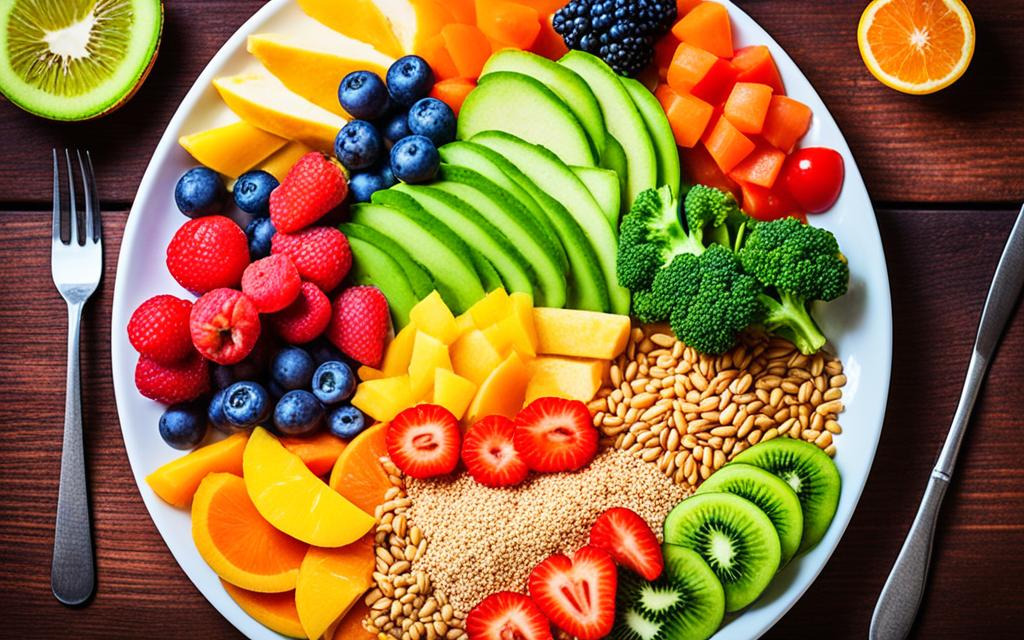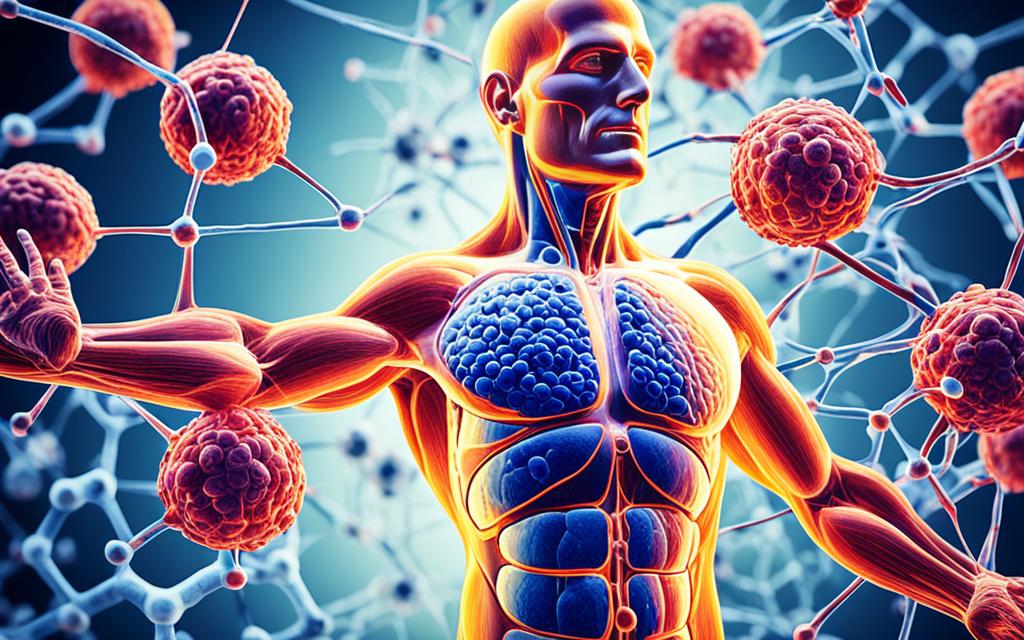Understanding Insulin Resistance: What Is It?
As you explore the realm of metabolic health, you’ll surely come across insulin resistance. But what exactly is it? This condition is crucial for many body functions and greatly impacts your metabolism. Understanding it is vital for everyone, not just doctors and patients. Insulin resistance happens when your body’s cells don’t properly react to insulin. This leads to various symptoms and can pose health challenges.
Insulin resistance affects how your body handles glucose, causing high blood sugar levels. Over time, this can result in severe complications. By learning more about it, you can spot symptoms early on. This helps you manage or even prevent problems linked to this condition.
Key Takeaways
- Insulin resistance is a vital concept in understanding your metabolic health.
- Recognizing insulin resistance symptoms can lead to early diagnosis and better management.
- Understanding the condition helps in mitigating potential insulin resistance complications.
- Knowledge of insulin resistance empowers patients and health care providers alike.
- Insight into insulin resistance lays the groundwork for preventative and management strategies.
The Basics of Insulin Resistance
Understanding insulin resistance begins with its fundamentals. First, we learn what it is and how it functions in the body. Then, we see how it differs from normal insulin activity. Knowing these points is key for managing, diagnosing, and treating insulin resistance effectively.
Defining Insulin Resistance
Insulin resistance is when the body’s cells don’t react well to insulin. This hormone, made by the pancreas, controls our blood sugar. Because of this resistance, the pancreas works harder, making more insulin. This can lead to high blood sugar and health problems over time.
How Insulin Works in the Body
Insulin helps move glucose from our blood into our cells for energy. Normally, this keeps our blood sugar levels just right. It supports our daily activities and keeps us healthy.
What Distinguishes Insulin Resistance?
Insulin resistance means the body struggles to use the insulin it makes. Sometimes, people need medical help to manage it. Understanding the difference helps doctors create better treatment plans. These plans help patients deal with insulin resistance more effectively.
Table 1: Comparison of Normal Insulin Function vs. Insulin Resistance
| Aspect | Normal Insulin Function | Insulin Resistance |
|---|---|---|
| Insulin Sensitivity | High | Low |
| Blood Sugar Levels | Stable | Often Elevated |
| Insulin Production | Normal | Increased |
| Health Impact | Minimal | Increased Risk of Complications |
Learning about insulin resistance is vital for treatment. Whether for better management or diagnosis, the basics are the starting point. This information helps people make informed health decisions. It enables them to effectively tackle insulin resistance.
Insulin Resistance Causes and Risk Factors
Exploring insulin resistance causes shows both genes and lifestyle matter. Knowing these can help you avoid or manage it better. Let’s look at how your DNA and daily life affect insulin resistance. And we’ll discuss ways to prevent insulin resistance.
Genetic Predisposition
Your genes may make you more likely to get insulin resistance. It’s common in some families. Genes change how your body handles insulin. This could increase your resistance to it. Knowing your family’s health history is key to early management.
Lifestyle and Environmental Factors
How you live affects insulin resistance. Diet, exercise, and stress impact how well your body uses insulin. Let’s dive deeper into these factors.
- High-Sugar Diets: Too much sugar can lead to more body fat and weight. This makes insulin resistance more likely.
- Physical Inactivity: Staying active improves insulin sensitivity. Not moving much raises your risk of insulin resistance.
- Stress: Constant stress boosts cortisol levels. This hormone can increase insulin resistance.
Making smart lifestyle choices is vital for insulin resistance prevention. Better choices can reduce your risk. Changing how you live can prevent insulin resistance and boost overall health.
| Lifestyle Factor | Impact on Insulin Resistance | Prevention Strategy |
|---|---|---|
| Diet | High sugar intake increases risk | Switch to a balanced diet with low GI foods |
| Exercise | Lack of exercise increases risk | Incorporate at least 150 minutes of moderate exercise weekly |
| Stress Management | Chronic stress contributes to higher cortisol levels | Engage in regular stress-reducing activities like yoga or meditation |
In conclusion, genes and lifestyle both affect insulin resistance. Taking good care of your diet, staying active, and managing stress are key. These actions are a strong defense against insulin resistance prevention.
Recognizing Insulin Resistance Symptoms
Insulin resistance is growing in today’s world. Knowing the small signs can be key for early help and better health. It’s about catching it early to start treatment sooner rather than later.
Common Physical Indicators
If you’re gaining weight unexpectedly or always hungry, you might be seeing early signs. Fatigue, darker skin patches around the neck and armpits, and getting infections often are other clues. These symptoms compared to what’s normal can point towards insulin resistance.
When to See a Doctor
Figuring out if what you feel is due to insulin resistance or something else can be hard. This makes people wait to get help. But if you keep having these issues, seeing a doctor is key. They can diagnose you correctly and start the right treatment.
| Symptom | Commonality | Action to Take |
|---|---|---|
| Increased thirst and urination | Very Common | Consult doctor for glucose tests |
| Unusual weight gain | Common | Discuss possible insulin resistance |
| Skin changes (Acanthosis Nigricans) | Frequent | Seek dermatological assessment |
Watching out for these signals and taking action can change the game in managing insulin resistance. Recognize the symptoms and quickly get medical advice. The right diagnosis and treatment plan is vital.
Complexities in Insulin Resistance Diagnosis
Finding out if someone has insulin resistance is very important, yet can be tricky. It requires various tests and a detailed analysis to gauge how severe the issue is. We’ll look into the key steps for diagnosing and the challenges in understanding the test outcomes.
Tests and Procedures
Doctors usually start with a fasting insulin test and a glucose test to diagnose insulin resistance. These initial tests check how your body’s insulin and glucose levels work together after you haven’t eaten for a while. The HOMA-IR (Homeostatic Model Assessment for Insulin Resistance) is another way to measure insulin resistance. It uses your fasting blood sugar and insulin levels to create a clear picture.
Interpreting Diagnosis Results
Reading these test results needs a lot of know-how, as high levels often hint at early insulin resistance issues. A glucose tolerance test shows how fast your body gets rid of glucose. This is key for diagnosing and managing insulin resistance.
It’s better to look at test results over time instead of just once. This helps doctors make a right diagnosis. Then, they can create a treatment plan just for you. This lowers the chance of further health problems.
It’s crucial to understand these outcomes when looking at insulin resistance and other health indicators. This knowledge helps in better controlling and preventing more metabolic issues.
Insulin Resistance Treatment Options
Managing insulin resistance is about combining medical help and life changes. Knowing all treatment ways is key for your health.
Medical Interventions
Medical interventions aim to make your body respond better to insulin. They help with your blood sugar and keep you healthy.
Medications Used for Treatment
Medicines are essential in treating insulin resistance. They mostly work by making insulin work better, lowering liver glucose, and increasing insulin from the pancreas. Here are some important medicines:
- Metformin – Often the first choice, it lowers liver glucose and helps insulin work better.
- Thiazolidinediones – These boost insulin sensitivity, helping muscles and fat absorb more glucose.
- Sulfonylureas – They push the pancreas to make more insulin.
- GLP-1 receptor agonists – These shots slow digestion and help drop sugar levels.
These medications are powerful in managing insulin resistance. But, they should be part of a bigger health plan and used with a doctor’s guidance.
Using these treatments together can greatly improve insulin sensitivity. It can help control or avoid insulin resistance issues. Always work with your health care provider to get a plan that fits you.
Comprehensive Insulin Resistance Management
Managing insulin resistance needs a focused approach. This includes lifestyle changes and keeping an eye on health. A proper diet and lifestyle adjustments are key for success.
Incorporating Lifestyle Changes
To fight insulin resistance, it’s important to change daily routines. This means eating a balanced diet with whole grains, leafy greens, and lean proteins. It also means eating less processed food and sugar. Adding regular exercise is crucial too. Mixing aerobic exercises, strength training, and flexibility exercises can help improve insulin use in your body.
Monitoring and Adjusting Treatment
Keeping track of your health is just as important as lifestyle changes. Regular doctor visits and blood tests are needed to keep an eye on blood sugar and insulin. Your doctor might change your treatment based on these tests. This could mean different meds or diet changes to better manage insulin resistance.
| Element | Recommendation | Reason |
|---|---|---|
| Diet | High fiber, low sugar | Improves insulin sensitivity |
| Exercise | Minimum 150 minutes per week | Reduces blood glucose levels |
| Monitoring | Regular health check-ups | Tracks changes and adjusts treatment |
The Role of Diet in Combating Insulin Resistance
Changing your diet is essential in controlling insulin resistance. What you eat can greatly reduce symptoms and boost your health. This section shows important diet changes and foods to avoid for better insulin sensitivity.
Recommended Dietary Modifications
Eating for insulin resistance means choosing foods that keep blood sugar stable. Here are some diet changes to help:
- Increase high-fiber food intake like whole grains, legumes, vegetables, and fruits.
- Include omega-3 sources such as fish, flaxseeds, and walnuts for better insulin sensitivity.
- Opt for lean proteins to maintain energy and manage hunger without raising blood sugar.
Foods to Avoid and Why
Some foods can make insulin resistance worse. Knowing which foods to skip is key:
| Food Type | Reason to Avoid |
|---|---|
| Refined Carbohydrates | They lead to quick increases in blood sugar and insulin. |
| Sugary Beverages | They are sugary, causing insulin spikes and weight gain. |
| Fried Foods | High in bad fats, they add to body fat and worsen insulin resistance. |
| Processed Meats | They may contain hidden sugars and unhealthy preservatives, hurting insulin sensitivity. |
Knowing about these foods is crucial in dealing with insulin resistance. By changing your diet and avoiding certain foods, your body can better manage insulin. This leads to improved health.

The Importance of Exercise in Counteracting Insulin Resistance
To manage insulin resistance treatment, adding regular physical activity to your day is crucial. Exercise not only helps with weight control but also boosts your body’s ability to manage blood sugar. Learning about how consistent exercise can change insulin management and lessen health risks is important.
Exercise has a big role in fighting insulin resistance because it helps muscles use glucose during and after a workout. When you exercise, muscles use more glucose which continues even after you’re done, thanks to a process called GLUT4 activation. This makes your body better at using glucose, which is good for insulin sensitivity.
Remember, the key to utilizing exercise as part of your insulin resistance treatment is consistency and diversity in your workouts.
- Aerobic exercises like walking, cycling, or swimming boost heart rate and cardiovascular health, which helps control blood glucose.
- Resistance training, such as lifting weights, increases muscle mass. This helps with glucose use and raises insulin sensitivity over time.
- Flexibility and balance workouts, like yoga and Pilates, improve movement and can lower stress levels, positively affecting insulin sensitivity.
Adding these types of exercise to your routine can make managing insulin resistance easier. Try to do a mix of these activities every week to get the most benefit.
| Type of Exercise | Benefit |
|---|---|
| Aerobic | Improves cardiovascular health and increases insulin sensitivity. |
| Resistance | Increases muscle mass which aids in better glucose control. |
| Flexibility and Balance | Reduces stress and improves overall metabolic function. |
For the best results, set clear goals, keep track of your progress, and change up your workouts to stay motivated and effective. Always talk to your doctor to make sure your exercise plan fits with your overall health and insulin resistance treatment needs.
Insulin Resistance What Is and Why It’s Crucial to Understand
Understanding insulin resistance what is and its impact is key for everyone. Insulin resistance is when the body does not respond well to insulin. This hormone is vital for controlling blood sugar levels. Learning about insulin resistance management allows you to improve your health.
By exploring insulin resistance what is, we can prevent and manage it. Doing so helps avoid diseases like Type 2 diabetes and heart problems. Knowing the signs and adopting insulin resistance management methods can improve life quality.
We aim to give you useful tips on handling insulin resistance. We’ll look at lifestyle changes and medical advice that help manage this issue.
| Lifestyle Change | Benefits |
|---|---|
| Dietary Adjustments | Improves insulin sensitivity, reduces blood sugar levels |
| Regular Physical Activity | Enhances muscle insulin uptake, decreases body fat |
| Stress Management | Lowers stress hormones that affect insulin effectiveness |
| Adequate Sleep | Regulates hormones, helps maintain blood sugar levels |
Knowing about insulin resistance what is and managing it can lower your health risks. By changing your lifestyle and getting regular health checks, you can handle or even reverse insulin resistance.
Insulin Resistance Complications to Be Aware Of
Understanding the wide range of health issues from insulin resistance is crucial. It helps you manage your health better. Knowing the short-term and long-term insulin resistance complications aids in making smarter health and lifestyle choices.
Short-Term and Long-Term Health Implications
At first, you might notice minor symptoms from insulin resistance. If not treated, it can worsen, impacting many body parts. This includes heart diseases to severe kidney issues. Catching and treating it early is key, showing why regular insulin resistance diagnosis is necessary.
Connection to Other Metabolic Disorders
Insulin resistance also ties closely with other health problems. This includes type 2 diabetes, high blood pressure, and abnormal cholesterol levels. This link raises the stakes, showing the need for a full health check-up.
To better understand how insulin resistance connects to other issues, look at this table:
| Insulin Resistance Complication | Related Metabolic Disorder | Impact Level |
|---|---|---|
| Hyperglycemia | Type 2 Diabetes | High |
| High Blood Pressure | Hypertension | Medium |
| Abnormal Cholesterol Levels | Dyslipidemia | Medium |
This shows why a whole-body approach to health checks is vital. It can help lower risks and lead to better health.
Effective Insulin Resistance Prevention Strategies
Fighting insulin resistance is key for good health over time. It’s mostly about what we eat and how active we are.
Maintaining a Healthy Weight
Keeping a healthy weight is crucial against insulin resistance. An insulin resistance diet packed with fruits, veggies, whole grains, and lean meats helps. Watching how much you eat and cutting back on sugary or fatty foods is key.
Regular Physical Activity and Its Impact
Exercise is powerful in preventing insulin resistance. It makes your body better at using insulin and lowers blood sugar. Mixing aerobic, strength, and flexibility exercises boosts insulin sensitivity and your overall health.
| Activity Type | Frequency | Insulin Sensitivity Improvement |
|---|---|---|
| Aerobic Exercise | 3-5 times per week | High |
| Strength Training | 2-3 times per week | Moderate to High |
| Flexibility Exercises | Daily | Moderate |
Insulin resistance diet and staying active help against insulin resistance. They boost your health and life quality.
Emerging Research and Future Outlook on Insulin Resistance
The insulin resistance treatment and management field is quickly changing. New research aims to change how we approach this condition in medicine. Many innovative studies are working on better ways to handle and maybe even reverse insulin resistance.
Latest studies are looking into the body’s paths involving insulin resistance. They’re finding new drug targets. These new treatments could improve how the body responds to insulin and have fewer side effects than current options.
Also, new technology is very important for better insulin resistance management. Tools like continuous glucose monitoring and wearable gadgets give live data. This helps in giving treatments that adjust to each person’s everyday life.
| Study Focus | Expected Outcome | Impact on Treatment |
|---|---|---|
| New Drug Therapies | Enhanced Insulin Sensitivity | More Precise Medication with Fewer Side Effects |
| Technological Innovations | Real-Time Data Collection | Personalized Management Plans |
| Dietary Intervention Trials | Better Dietary Recommendations | Improved Daily Management of Insulin Resistance |
Looking ahead, using AI and machine learning could lead to finding insulin resistance earlier. It could lead to better treatment plans. This might majorly change the outlook for people at risk.
These new paths offer hope for better results for patients. They show a move towards care that is more about the patient. The future in treating this complex issue looks bright. Continued research and tech growth are vital for its success.
Real-Life Stories: Managing Insulin Resistance Successfully
Managing insulin resistance is hard, but many have succeeded with the right steps and hard work. These stories show us how an insulin resistance diet and smart insulin resistance management can change lives. They give us clear examples to follow.
A software engineer from Seattle faced insulin resistance. He decided to change what he ate and how he lived. By eating less sugar and more fiber, he got healthier quickly. His story shows us how changing what we eat can make a big difference.
He learned about food at workshops. Daily exercise made him fitter and improved his insulin levels. Regular check-ups helped him stay on course.
- Educational workshops on nutrition helped him understand the importance of balancing macronutrients.
- A commitment to daily exercise increased his overall fitness and insulin responsiveness.
- Regular consultations with a healthcare provider ensured he remained on the right track.
A teacher from Atlanta also fought insulin resistance. She focused on her diet and followed doctor’s advice. Eating more veggies, grains, and lean meats boosted her energy. Her story proves how a well-planned insulin resistance diet works.
“Committing to this lifestyle change was challenging at first, but the positive effects on my health and well-being have made every step worth it.”
These examples guide those struggling with similar issues. They show that tailored approaches to insulin resistance management are key. Knowing that others have succeeded can inspire and direct those working towards better health.
Supplementary Resources for Further Education
Exploring various educational resources is key to understanding insulin resistance treatment and prevention. It helps whether you’re a health pro, a student, or just looking out for your well-being. Expanding your knowledge through credible sources is crucial. This helps in making healthier lifestyle choices and managing better. Here, you’ll find books, articles, and websites full of insight into insulin resistance.
| Resource Type | Title | Focus Area |
|---|---|---|
| Book | The Diabetes Code | Prevention and Management of Type 2 Diabetes |
| Article | Role of Diet in Insulin Resistance | Nutritional Approaches to Mitigate Insulin Resistance |
| Website | American Diabetes Association | Comprehensive Guides and Latest Research |
| Book | Why We Get Sick | Links Between Insulin Resistance and Chronic Disease |
| Article | Exercise and Its Role in Reducing Insulin Resistance | Physical Activity Recommendations and Benefits |
| Website | Centers for Disease Control and Prevention (CDC) | Prevention and Control Tips for Diabetes |
The selected resources offer top-notch info on preventing and treating insulin resistance. They’re perfect for enhancing your understanding. This is essential for managing your own health or helping others. Staying informed lets you make wise choices for a healthier life. Rely on trustworthy sources and keep building your knowledge on this important health issue.
Conclusion
This deep dive into insulin resistance gave you essential info to understand it, spot its causes, and know its symptoms. Spotting early signs is key to catching insulin resistance soon. This can help avoid more health problems down the line. This article stressed the importance of taking action early with the right food choices, staying active, and seeking medical help when needed.
To manage or prevent insulin resistance, adopting a healthy lifestyle is critical. Change your diet and keep moving to improve how your body uses insulin. Also, knowing how insulin resistance connects to other health problems shows why regular check-ups and talking with your doctor matter.
Insulin resistance is a growing issue with big health impacts, so keep learning and talking about it. Every positive step leads to better overall health. Stay informed, be proactive, and keep in touch with healthcare professionals to fight insulin resistance effectively.
FAQ
What exactly is insulin resistance?
Insulin resistance is when the body’s cells don’t react well to insulin. Insulin helps control blood sugar. If ignored, this may lead to higher blood sugar levels, setting the stage for type 2 diabetes and other health problems.
What are some common symptoms of insulin resistance?
Common signs include feeling very tired, having a strong hunger, finding it hard to focus, and gaining weight, especially around the belly. Still, many people might not notice these symptoms early on.
Can insulin resistance cause complications?
Yes, without proper attention, insulin resistance can cause serious health issues. These include type 2 diabetes, heart diseases, and polycystic ovary syndrome (PCOS).
How is insulin resistance diagnosed?
Doctors use blood tests to find insulin resistance. These tests check fasting insulin and glucose levels, and the Oral Glucose Tolerance Test (OGTT). They also consider symptoms and risk factors.
Are there medical treatments for insulin resistance?
Treatments can include medications like metformin. These medications make the body more sensitive to insulin. Changing one’s diet and exercise habits is also recommended. For some related conditions, more medicines might be needed.
What lifestyle changes can help manage insulin resistance?
Important changes are eating a balanced diet, exercising regularly, keeping a healthy weight, and managing stress. These can greatly improve insulin sensitivity.
What role does diet play in combating insulin resistance?
Diet is very important for managing insulin resistance. Eating foods that are low on the glycemic index, and rich in fiber can help. Avoiding foods high in bad fats is also crucial.
Which foods should be avoided if you have insulin resistance?
Stay away from foods high in sugar, refined carbs (like white bread and pasta), and processed foods. These can increase blood sugar levels and make insulin sensitivity worse.
How does exercise affect insulin resistance?
Exercise helps the muscles use blood sugar more efficiently. This lowers blood sugar levels. It also reduces the need for insulin, making the body respond better to it.
What strategies are effective for preventing insulin resistance?
Preventing insulin resistance involves eating healthily, staying active, keeping a normal weight, not smoking, reducing stress, and regular health checks. These help monitor and manage blood sugar levels.
How is insulin resistance related to other metabolic disorders?
Insulin resistance is linked to metabolic syndrome. This syndrome includes conditions like high blood pressure and abnormal cholesterol levels. It raises the risk of heart disease and type 2 diabetes.
Does insulin resistance only affect people who are overweight or obese?
While weight plays a major role, insulin resistance can also happen to people of normal weight. This is especially true if they have a family history of type 2 diabetes or other risk factors like a sedentary lifestyle.
Can insulin resistance be reversed?
Yes, insulin sensitivity can be improved with diet, exercise, and sometimes medication. Many individuals can achieve normal glucose levels again through lifestyle changes.
Is insulin resistance hereditary?
Genetics can influence insulin resistance. Some people are more likely to develop it because of their family background.
Where can I find more information about managing insulin resistance?
More information is available from healthcare providers, trustworthy websites like the American Diabetes Association, and scientific articles on endocrinology and metabolic health.







